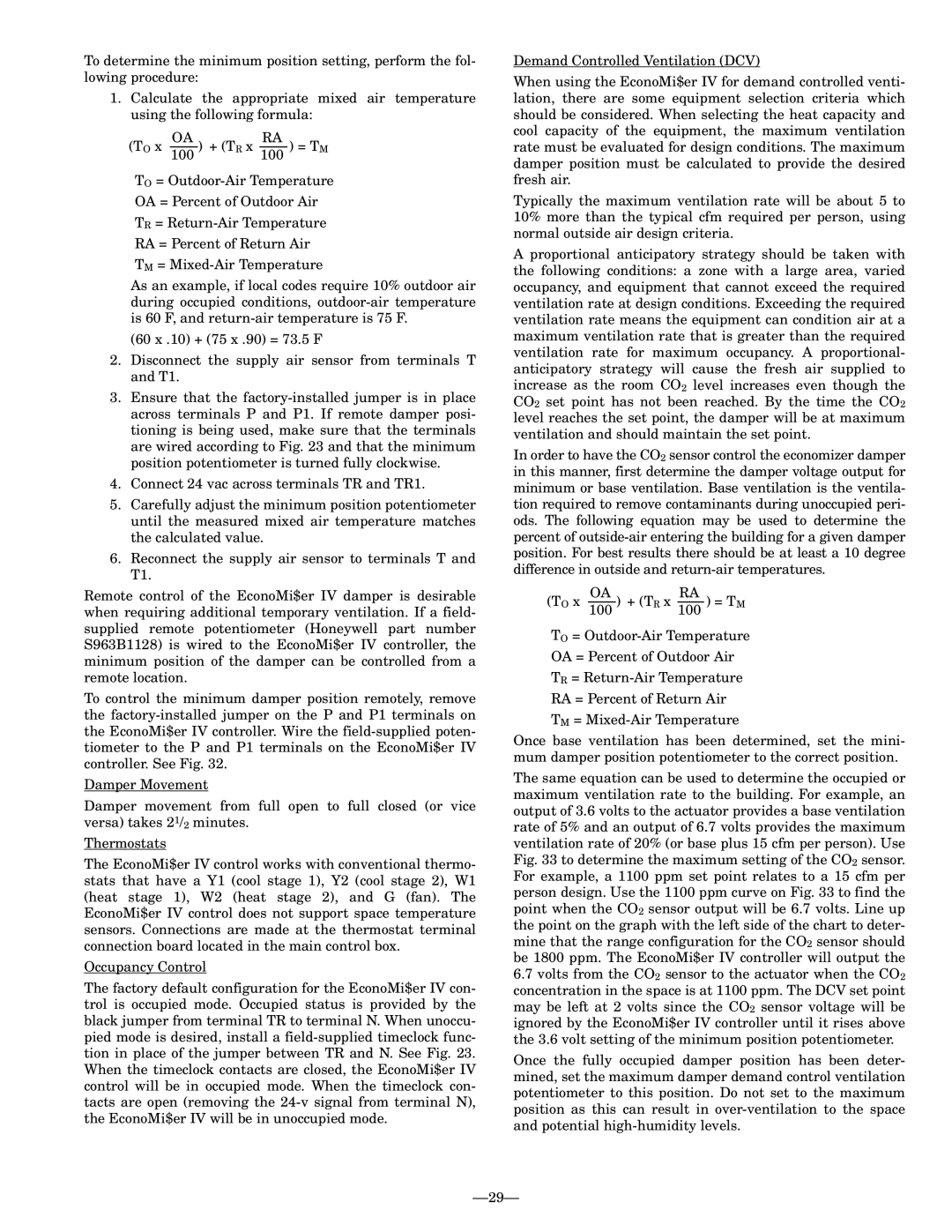To determine the minimum position setting, perform the fol- lowing procedure:
1.Calculate the appropriate mixed air temperature using the following formula:
(TO x | OA | RA |
100 ) + (TR x | 100 ) = TM |
TO = Outdoor-Air Temperature
OA = Percent of Outdoor Air
TR = Return-Air Temperature
RA = Percent of Return Air
TM = Mixed-Air Temperature
As an example, if local codes require 10% outdoor air during occupied conditions, outdoor-air temperature is 60 F, and return-air temperature is 75 F.
(60 x .10) + (75 x .90) = 73.5 F
2.Disconnect the supply air sensor from terminals T and T1.
3.Ensure that the factory-installed jumper is in place across terminals P and P1. If remote damper posi- tioning is being used, make sure that the terminals are wired according to Fig. 23 and that the minimum position potentiometer is turned fully clockwise.
4.Connect 24 vac across terminals TR and TR1.
5.Carefully adjust the minimum position potentiometer until the measured mixed air temperature matches the calculated value.
6.Reconnect the supply air sensor to terminals T and T1.
Remote control of the EconoMi$er IV damper is desirable when requiring additional temporary ventilation. If a field- supplied remote potentiometer (Honeywell part number S963B1128) is wired to the EconoMi$er IV controller, the minimum position of the damper can be controlled from a remote location.
To control the minimum damper position remotely, remove the factory-installed jumper on the P and P1 terminals on the EconoMi$er IV controller. Wire the field-supplied poten- tiometer to the P and P1 terminals on the EconoMi$er IV controller. See Fig. 32.
Damper Movement
Damper movement from full open to full closed (or vice versa) takes 21/2 minutes.
Thermostats
The EconoMi$er IV control works with conventional thermo- stats that have a Y1 (cool stage 1), Y2 (cool stage 2), W1 (heat stage 1), W2 (heat stage 2), and G (fan). The EconoMi$er IV control does not support space temperature sensors. Connections are made at the thermostat terminal connection board located in the main control box.
Occupancy Control
The factory default configuration for the EconoMi$er IV con- trol is occupied mode. Occupied status is provided by the black jumper from terminal TR to terminal N. When unoccu- pied mode is desired, install a field-supplied timeclock func- tion in place of the jumper between TR and N. See Fig. 23. When the timeclock contacts are closed, the EconoMi$er IV control will be in occupied mode. When the timeclock con- tacts are open (removing the 24-v signal from terminal N), the EconoMi$er IV will be in unoccupied mode.
Demand Controlled Ventilation (DCV)
When using the EconoMi$er IV for demand controlled venti- lation, there are some equipment selection criteria which should be considered. When selecting the heat capacity and cool capacity of the equipment, the maximum ventilation rate must be evaluated for design conditions. The maximum damper position must be calculated to provide the desired fresh air.
Typically the maximum ventilation rate will be about 5 to 10% more than the typical cfm required per person, using normal outside air design criteria.
A proportional anticipatory strategy should be taken with the following conditions: a zone with a large area, varied occupancy, and equipment that cannot exceed the required ventilation rate at design conditions. Exceeding the required ventilation rate means the equipment can condition air at a maximum ventilation rate that is greater than the required ventilation rate for maximum occupancy. A proportional- anticipatory strategy will cause the fresh air supplied to increase as the room CO2 level increases even though the CO2 set point has not been reached. By the time the CO2 level reaches the set point, the damper will be at maximum ventilation and should maintain the set point.
In order to have the CO2 sensor control the economizer damper in this manner, first determine the damper voltage output for minimum or base ventilation. Base ventilation is the ventila- tion required to remove contaminants during unoccupied peri- ods. The following equation may be used to determine the percent of outside-air entering the building for a given damper position. For best results there should be at least a 10 degree difference in outside and return-air temperatures.
| OA | RA |
(TO x | 100 ) + (TR x | 100 ) = TM |
TO = Outdoor-Air Temperature
OA = Percent of Outdoor Air
TR = Return-Air Temperature
RA = Percent of Return Air
TM = Mixed-Air Temperature
Once base ventilation has been determined, set the mini- mum damper position potentiometer to the correct position.
The same equation can be used to determine the occupied or maximum ventilation rate to the building. For example, an output of 3.6 volts to the actuator provides a base ventilation rate of 5% and an output of 6.7 volts provides the maximum ventilation rate of 20% (or base plus 15 cfm per person). Use Fig. 33 to determine the maximum setting of the CO2 sensor. For example, a 1100 ppm set point relates to a 15 cfm per person design. Use the 1100 ppm curve on Fig. 33 to find the point when the CO2 sensor output will be 6.7 volts. Line up the point on the graph with the left side of the chart to deter- mine that the range configuration for the CO2 sensor should be 1800 ppm. The EconoMi$er IV controller will output the
6.7volts from the CO2 sensor to the actuator when the CO2 concentration in the space is at 1100 ppm. The DCV set point may be left at 2 volts since the CO2 sensor voltage will be ignored by the EconoMi$er IV controller until it rises above the 3.6 volt setting of the minimum position potentiometer.
Once the fully occupied damper position has been deter- mined, set the maximum damper demand control ventilation potentiometer to this position. Do not set to the maximum position as this can result in over-ventilation to the space and potential high-humidity levels.
